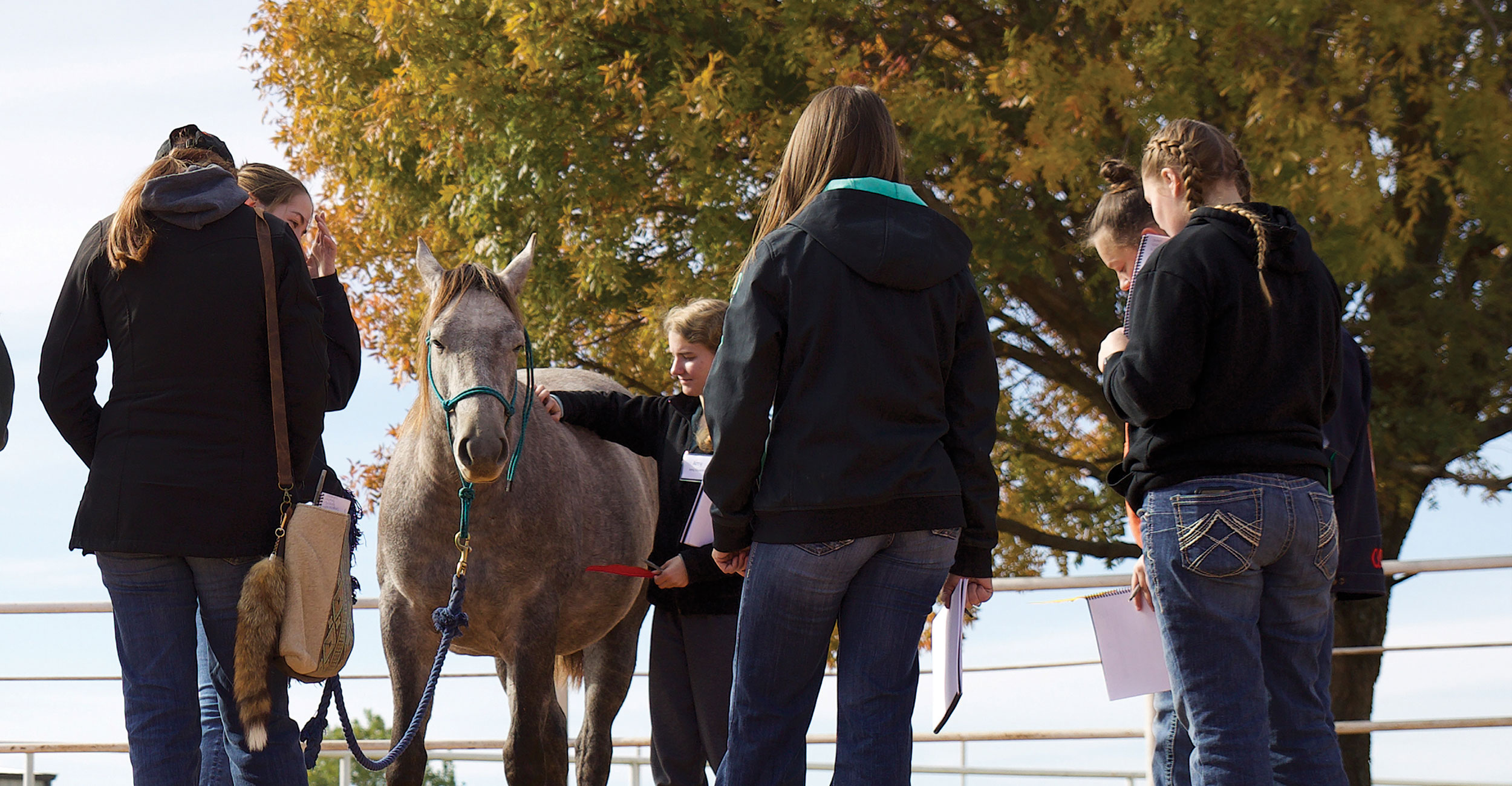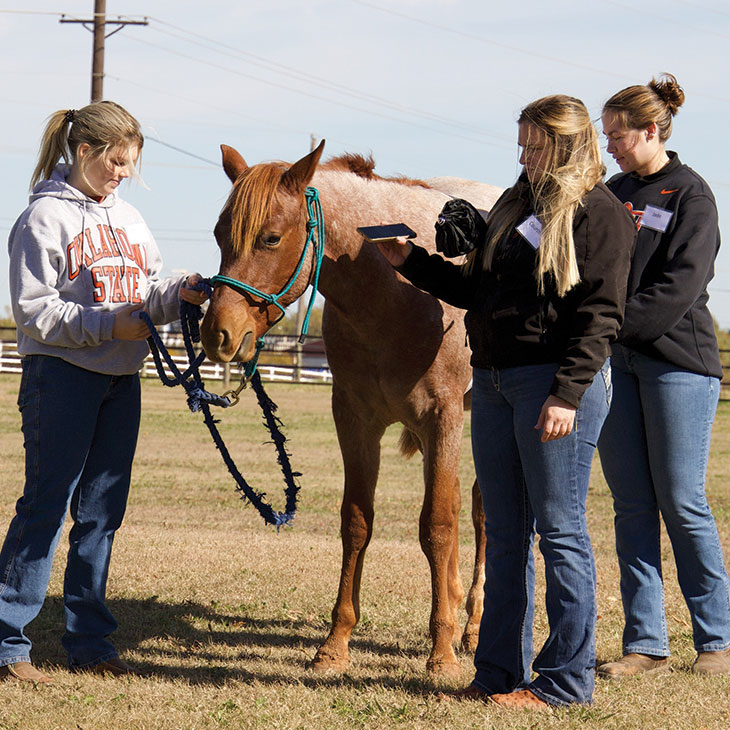
No Horsing Around
Friday, December 17, 2021
Media Contact: Samantha Siler | Communications and Marketing Manager | 405-744-2977 | samantha.siler@okstate.edu
On a chilly morning in November, 40 high school students came together eager to learn about their favorite animal — the horse.
What they did not know was they also would learn about STEM disciplines through the Oklahoma State University Horse Science Academy.
Kris Hiney, OSU Extension’s equine specialist, founded the youth academy seven years ago to share her passion for horses and for science, technology, engineering and math, she said.
“I was never a person who just liked the riding part,” Hiney said. “I really appreciated the horse as a unique animal and its physiology.”
During Hiney’s 12 years as a faculty member at the University of Wisconsin-River Falls, she liked getting her students interested in science through unique and elaborate lab opportunities, she said.
When she moved to OSU in 2014 she realized she missed teaching students, Hiney said.
“I have a passion for doing all these cool things and no way to do them,” Hiney said. “So, why not offer this chance to high school students?”
Horse Science Academy was created to educate high school students with an interest in horses about science and math, she said.
Hiney took what she did at UWRF and modified the curriculum to be applicable for high school students, she said.
“They say when you know something well enough, you should be able to teach it, and that is what Dr. Hiney is doing with this event,” said Mandy Brace, veterinary medicine student and former undergraduate volunteer for the 2019 Horse Science Academy. “It’s a lot of deep information, but Dr. Hiney is really gifted at taking something that is in-depth and condensing it into understandable chunks.”
Hiney said she structured the academy to have a four-year topic rotation. The benefit to having a four-year rotation is the youth can participate every year and learn new material each time, she added.

“Each topic is based on something I am interested in and like to teach,” Hiney said. “I try to take my interests and turn them into something fun for the kids.”
The annual one-day academy presents one of the following topics: equine anatomy, internal parasites, the equine athlete, equine behavior, immunology and wound care.
Hiney said the idea is to present these topics in a way the students will understand by starting with a short lecture followed with hands-on applications. In addition, team-building exercises conducted in their small groups get them interacting with others, she added.
“Students get more excited and interested when they can actually see and touch what we are talking about,” Hiney said.
Brittani Kirkland, Hiney’s graduate teaching assistant from 2017 to 2019, said the process for teaching the material is to ensure they start with a good foundation of knowledge and progress throughout the day.
In 2018, the academy’s topic was equine anatomy. At the end of the event, the youth participated in an equine limb dissection. Building on their foundation throughout the day allowed them to better understand what they were doing in the dissection process, she said.
The 2021 academy started with learning simple equine anatomy terms followed by labeling the horse skeleton through competitions to make the process interactive and fun, Kirkland said.
Building on that knowledge, the students went outside and labeled a horse then labeled their peers to compare their skeleton anatomy. They then palpated the horse’s legs to feel for muscles and tendons before finally getting to dissect an equine limb.
“Horse Science Academy taught me how effective hands-on learning is,” Kirkland said. “It’s highly likely these kids will not go into a career with horses, but they have still learned these STEM pieces effectively that can go with them everywhere.”
In addition to Hiney’s graduate student, at least five undergraduate students serve as group leaders during the academy.
Kirkland said each year the student helpers meet once a week for a month in advance to learn the topics and labs that will be taught.
“One thing we always try to incorporate is active learning with the theory to keep them engaged,” said Will Funk, former student volunteer who completed his OSU bachelor’s degrees in biology and natural resource ecology and management.
During the active learning portion, the students were separated into groups of four to five and participated in activities or games led by a college student to get them thinking and interacting with each other, Funk said.
“The small groups definitely helped because we were able to interact with kids one on one versus the lecture teaching method,” Funk said. “Seeing them really get into the topics and getting to be involved with active learning was really cool. It was definitely just as much of a learning environment for me as it was the kids.”
Funk said he enjoyed seeing the students thinking about theorical science and being excited to answer questions.
The youth already had a background with horses, but the Horse Science Academy provides them with a deeper knowledge into the physiology and science of horses, he said.
Karson Frans, a fourth-year Horse Science Academy attendee, said he attended the academy because he could learn more about horses through an experience he wouldn’t get elsewhere. “The lectures just scratch the surface,” Frans said. “Whenever we get hands on is when I learn more then someone speaking at me.”
This year’s topic was equine behavior and the science of wound healing. Hiney said the youth started the day with learning the science of training horses and their natural behavior and biology of equine sciences. Students made observations as scientists and conducted experiments on how the horses’ senses work and create a reaction, Hiney added.
In the afternoon, the students learned the basics of first aid, how wounds heal and an introduction to surgery, she added.
The cost of attendance was $40 per student, which included a day of hands-on learning, lunch, a lab notebook and supplies they could take home with them, Hiney said.
“The program touches casual horse kids who may not be science-minded,” Hiney said, “but it gets them excited and helps them relate to what they may be doing in their science classes.”
The horse itself can be an effective tool to teach youth numerous STEM aspects, she added.
“What I love about this program is Dr. Hiney is fueling the curiosity and desire to learn through providing these cool opportunities they normally wouldn’t get in high school or even in their undergraduate degrees,” Brace said. “Kids were inspired that day, and imagine seven years of that. Horse Science Academy is certainly the future of agriculture and veterinary medicine we need.”
Story By: Sydney Miller | Cowboy Journal
